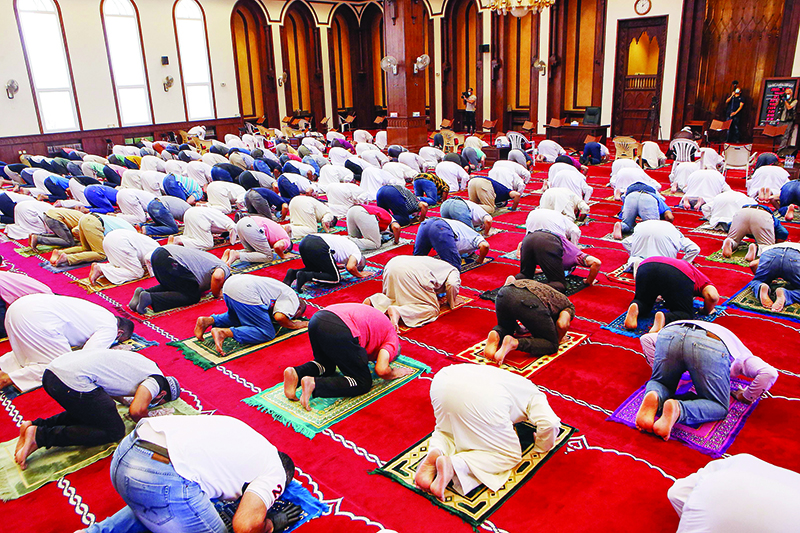
TEHRAN: Iran’s President Hassan Rouhani said yesterday that 25 million Iranians have been infected with the coronavirus and that another 35 million are at risk of acquiring it. The figures, which Rouhani said were based on a new Health Ministry report, are far higher Iran’s official toll of 269,440 infected. Rouhani in a televised speech did not address the discrepancy.
Iran, with a population of more than 80 million, has been the Middle East country hardest hit by the epidemic. “Our estimate is that as of now 25 million Iranians have been infected with this virus and about 14,000 have lost their dear lives,” Rouhani said in the speech.
Continued on Page 2
“There is the possibility that between 30 and 35 million other people will be at risk,” he said. “In total, more than 200,000 people have been hospitalized,” he said. The health ministry on Friday said 13,791 people had died from COVID-19.
“We have not yet achieved herd immunity and we have no choice but to be united and break the chain of transmission of the coronavirus,” Rouhani added. It appears to be the first time a senior Iranian official has indicated the country is seeking to defeat COVID-19 via herd immunity. Rouhani’s deputy head of communications, Alireza Moezi, said on Twitter hours later that the 25 million refers to “those who have encountered the virus and achieved complete immunity”.
Meanwhile, coronavirus cases in India passed one million on Friday, official data showed as authorities struggle to check the spread of the deadly pandemic across the world’s second-most populous nation. With over 600 Indians dying daily, lockdowns are being re-imposed across the country of 1.3 billion following an easing of restrictions in recent weeks on hopes the outbreak was under control.
Health ministry data released Friday put the total cases recorded at 1,003,382, a jump of almost 35,000, with 25,602 deaths after an increase of 687 — both new daily records. India, home to some of the planet’s most densely packed cities, is the third nation to hit a million cases after the United States and Brazil, although the numbers of deaths in those two countries are far higher.
Also, Bollywood star and former Miss World Aishwarya Rai Bachchan has been moved to a Mumbai hospital along with her eight-year-old daughter Aaradhya, nearly a week after they were revealed to have the coronavirus, media reports said. They had been in self-quarantine at home but the Times of India newspaper said they were moved to the Nanavati Hospital on Friday after complaining of “breathlessness”. “They are fine,” a hospital source told Press Trust of India news agency. Her actor husband Abhishek Bachchan and superstar father-in-law Amitabh Bachchan are already in the same hospital.
The International Federation of Red Cross and Red Crescent Societies said Thursday that India, Pakistan and Bangladesh are together fast becoming the next epicenter of the virus. “While the world’s attention has been focused on the unfolding crisis in the United States and South America, a concurrent human tragedy is fast emerging in South Asia,” the organization said. “COVID-19 is spreading at an alarming rate in South Asia, home to a quarter of humanity.”
Until now India’s main hotspots have been the megacities of Mumbai and New Delhi, but recently smaller cities and rural areas - where 70 percent of Indians live - have begun to raise the alarm. Goa on Thursday evening became the latest state to go under lockdown, imposing a three-day shutdown and a nighttime curfew until Aug 10. Chief Minister Pramod Sawant said too many people were “stepping out to meet people at parties” and there was a low level of “awareness and sensitivity”.
The coastal tourist region followed Bihar, one of India’s most impoverished states and home to 125 million people, in reintroducing curbs after IT hub Bangalore did so earlier in the week. Other areas have also brought back restrictions including parts of badly-hit Tamil Nadu and Kerala - previously lauded as a success story - as well as Assam.
But the situation on the ground in Bihar underscored the challenges in keeping the pandemic in check. The streets of state capital Patna were still teeming with traffic and people after the lockdown began, many ignoring social distancing advice and not wearing masks. “The lockdown is not being fully enforced,” local businessman Ranjeet Singh complained.
With per capita spending on health care among the lowest in the world, India’s hospitals are reeling. Frontline staff, especially in rundown state-run hospitals, are working punishingly long shifts with often shoddy protective equipment. “COVID patients often get delirious. They refuse to eat, pull away their tubes and even get violent with us,” Showkat Nazir Wani, a doctor at one hospital in Uttar Pradesh state told AFP.
Many experts say India is not testing enough people or properly recording fatalities, meaning the true caseload is likely much higher. The tally is “almost certainly underestimated”, Gautam Menon, a professor of physics and biology at India’s Ashoka University, told AFP. “We feel it might be underestimated by a factor of maybe something like 20 to 30... And maybe that number could be even larger. We have no idea at the moment.” - Agencies









